词汇学第四章
- 格式:ppt
- 大小:123.00 KB
- 文档页数:35

Key Points of “English Lexicology”Chapter 4Word Formation(1)The expansion of vocabulary in modern English depends chiefly on word-formation.The most productive means of word formation are affixation, compounding and conversion.Affixation: 30%-40%, compounding: 28%-30%, conversion: 26%, shortening (clipping and acronymy): 8%-10%, blending and others 1%-5%.Rules themselves are not fixed but undergo changes.There are always exceptions to rules of word-formation.4.1 AffixationAffixation is defined as the formation of words by adding word forming or derivational affixes to bases.According to their position, affixation falls into prefixation and suffixation.1. PrefixationPrefixation is the formation of new words by adding prefixes to bases. Prefixes do not change the word-class of the base but only change its meaning.The major prefixes can be classified into 10 categories by their meaning.1. Negative Prefixes否定前缀Of this group, un- is by far the most productive.2. Reversative or privative prefixes逆反(反向)前缀Prefixes of this group are repetition of most of the first set.3. Pejorative prefixes贬义前缀4. Prefixes of degree or size程度或大小前缀5. Prefixes of orientation and attitude倾向和态度前缀6. Locative prefixes方位前缀7. Prefixes of time and order时间和顺序前缀8. Number prefixes数字前缀9. Conversion prefixes转类前缀10. Miscellaneous prefixes其它前缀2. SuffixationSuffixation is the formation of new words by adding suffixes to bases.The primary function of suffixes is to change the grammaticalfunction of the base, i. e. the change of the word class with a slight modification of meaning.Suffixes can be grouped on a grammatical basis.If we call a suffix a noun suffix, that means when it is added to the base, whatever class it belongs to, the result will be a noun.1) Noun suffixes 名词后缀(1) Denominal nouns 从名词派生的名词Concrete: Noun base→Concrete nounAbstract: Noun base→Abstract noun(2) Deverbal nouns从动词派生的名词V erb base→agential noun (行为者名词)V erb base→abstract noun, denoting action, result, process, state, ect.(3) De-adjective nouns从形容词派生的名词(4) Nouns and adjectives suffixesBase→both nouns and adjectives2) Adjective suffixes(1) Denominal suffixes从名词派生的形容词(2) Deverbal suffixes从动词派生的形容词3) Adverb suffixes-wise表示“方向”、“样子”、“状态”、“在…方面”,现代英语中最后一种意义用得比较多,如:ostrich-wise 像鸵鸟一样地sleep-walker-wise像梦游者一样percetage-wise 就百分比来说calorie-wise 就卡路里来说educationwise 就教育方面来说weatherwise在气候方面taxwise 在赋税方面curriculumwise 就课程方面来说housingwise 就住房问题来看4) V erb suffixes补充:petrify 吓呆petroleum 石油fame 名声,声望infant 婴儿sist, stitut, sta, st=to stand(站立)assist, consist, exist, constituent, persist, stable, establish, obstacle, static, statue, circumstance, distant, ecstasy, prostitute。
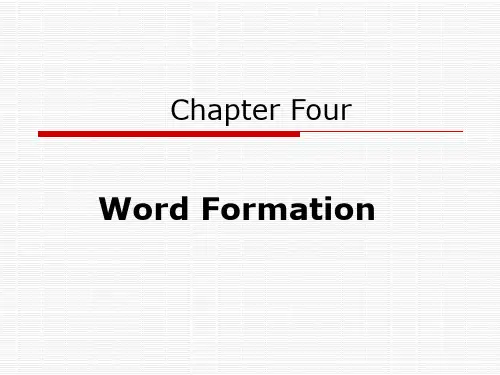
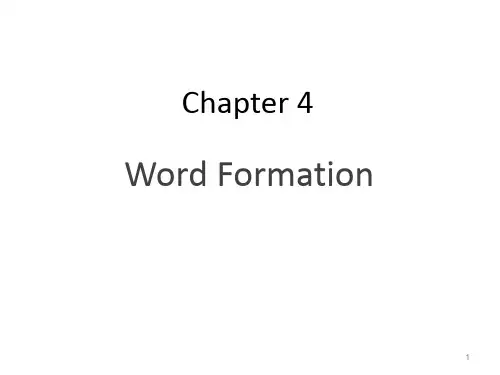
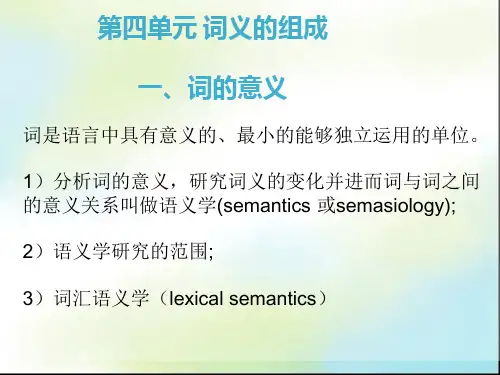
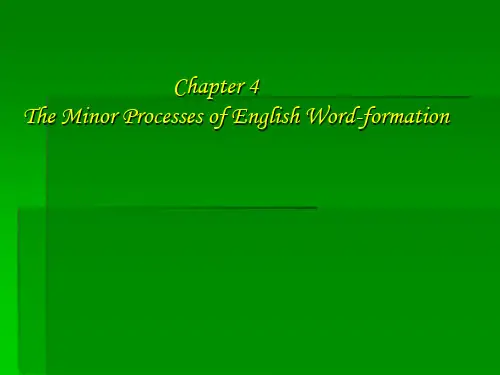
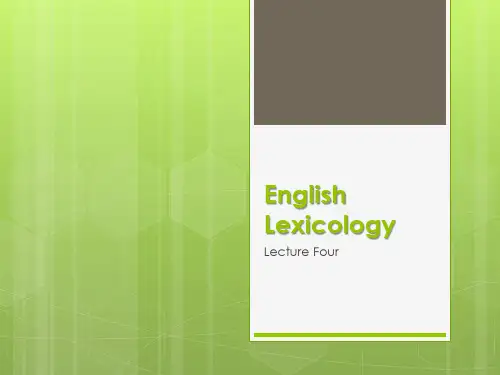

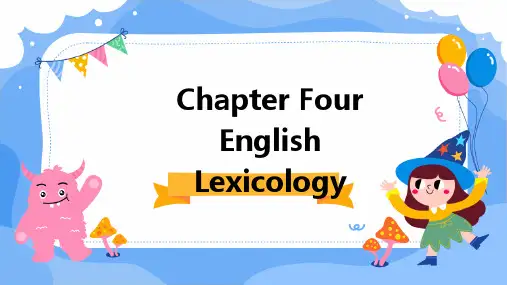
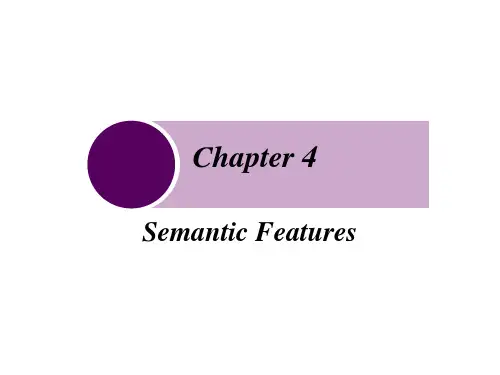
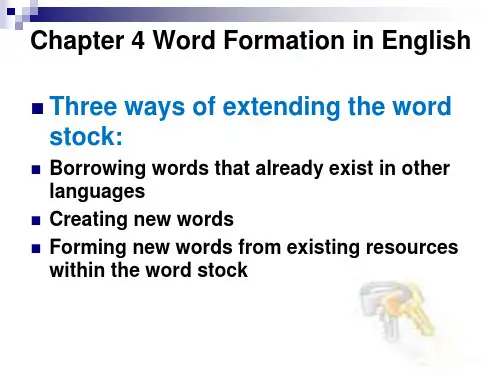
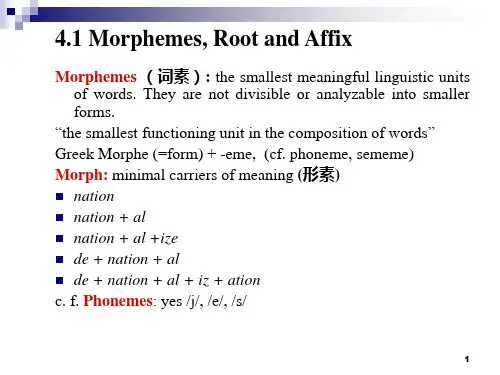
Unit 4 Significance of Words一、Significance of wordsI. Definition of SignificanceSignificance of words is the nominating things, behaviors and qualities. ——PlatoA Word is the symbol of a singular definition, always pointing to its definition. ——Wilhelm von HumoldtII. What is Semantic meaning?In a broad sense, semantic meaning represents human’s thinking and thoughts. Without semantic meaning, people couldn’t achieve the mutual communication and understanding.In a narrow sense, semantic meaning refers to the language meaning of the words and sentences, also called the word’s meaning and the sentence’s meaning.一般来说,研究意义特别是研究语言意义的学科被称为语义学(semantics or semasiology)。
I. 以下各句中country表示不同的意思,从B栏中选出country在A栏各句中的准确意义:A1. What do you mean by a farming country?2. The candidate has won the sixty percent of the country.3. There is a great gap between rich and poor countries.4. The children are looking forward to havinga picnic in the country next week.5. The young scientist left his country and went on with his medical research abroad.Ba.a nation or a state with its land or population.b.T he nation or state of one’s birth or citizenshipc.The people of a nation or stated.L and with a social nature or charactere.The countrysideII. 根据词义的拟声理据,将下列B栏中模拟动物叫声的词语与A栏中对应的动物名称词相配:AApes-, bears-, beetles-, birds-, bulls-, cats-, cattle-, crickets-, doves-, donkeys -, ducks-, flies-, foxes-, geese-, hens-, larks-, mice-, monkeys-, owls-, pigs-, , ravens-, sheep-, snakes-, swans-, turkeys-, wolves-.BSing, buzz, bray, gibber, neigh, quack, coo, cry, chatter, bellow, growl, hoot, bleat, low, hiss, grunt, drone, purr, yelp, squeak, gabble, howl, gobble, cluck, chirp, warble, croak ChauvinismApes-gibber, bears-growl, beetles-drone, birds-Sing, bulls-bellow, cats-purr, cattle -low, crickets-chirp, doves-coo, donkeys -bray, ducks-quack, flies-buzz, foxes-yelp, geese-gabble, hens-cluck, larks-warble, mice-squeak, monkeys-chatter, owls-hoot, pigs-grunt, oink, ravens-croak,sheep-bleat, snakes-hiss, swans-cry, turkeys-gobble, wolves-howl.三、词义的分类I.conceptual meaning概念意义可分解成若干个最小的意义单位II.connotative meaning词的内涵意义因人而异、因不同年龄而异某些词语的内涵意义带有民族性特征III.social meaning如: daddy, male parent, fatherdomicile, residence, abode, homeIV.affective meaningappreciative and pejorative (褒义和贬义)V.reflective meaning禁忌词taboo words “委婉词语”euphemistic expressionsVI.collocative meaningpretty: girl, lady, woman, flower, garden, color,villagehandsome: boy, man, car, vessel, overcoat, palace, airlinerVII.thematic meaninga.Mrs. Smith donated the first prize.b.The first prize was donated by Mrs. Smith.四、词义分析Semantic Analysis Componential Analysis and Semantic Field Theory语义成份分析法和语义场理论ponential AnalysisII.Semantic Field Theory1.a nimal2.1. domestic animal 2.2.wild animal2.1: chicken, cat, dog, pig, sheep, cow, horse, 2.2: panda, monkey, wolf, tiger, lion, elephant, 1. 语义场的三层次性质1)层次性2)系统性3)相对性2. 语义场的类型1)分类义场2)顺序义场3)关系义场可分为同义义场(synoymy)和反义义场(antonymy)。
Chapter 4Affixation 词缀法(30%-40%)Compounding 复合构词法(28%-30%)Conversion 转类法(26%)Shortening 缩略法(8%-10%)包括(clipping截短法acronymy 首字母拼音法)Blending 拼缀法(1%-5%)Affixation 词缀法Affixation, also called derivation派生法(derivatives派生词),is the formation of new words by adding affixes to stems.Affixation is the formation of word by adding word-forming or derivational affixes to stems. Prefixation 前缀法Prefixation is the formation of new words by adding prefixes to stems.Feature: prefixes do not generally change the word –class of the stem but only modify its meaning.Classification: we shall classify prefixes on a semantic basis into nine groups.Negative prefixes否定意义的词缀:a-,dis-,in-(il-,ir-,im-),non-,nu-.Reversative prefixes逆向意义的词缀:de-,dis-, un-. . de-compose ,unwarp.Pejorative prefixes贬义的词缀: mal-, mis- ,pseudo-. . mistrust , pseudo-friend.Prefixes of degree or size表示程度、大小等意义的词缀: arch-, extra- ,hyper- ,macro- ,micro- ,mini- ,out- ,over- ,sub- ,super-,sur-, ultra- ,under- . . archbishop , hyperactive ,superfreeze. Prefixes of orientation and attitude表示倾向和态度等意义的前缀:anti-, contra- ,counter- pro- . . anti-government,Locative prefixes方位意义的词缀:extra-,fore- ,inter- ,intra- ,tele-, trans-. . extraordinary, telecommunication,Prefixes of time and order表示时间和顺序的词缀:ex-,fore-, post- ,pre- ,re- . . ex-professor , foretell ,post-election.Number prefixes数字的前缀: bi- ,multi- , poly- ,semi-, hemi- ,tri- ,uni- ,mono-. .multi-purpose ,semi-naked, tricycle, monorail.Miscellaneous prefixes其他种类意义的前缀: auto- ,neo- ,pan- , vice- . .autobiography ,vice-chairman.Suffixation 后缀法Suffixation is the formation of new words by adding suffixes to stems.Feature: suffixes mainly change the word class.Classification: we shall group suffixes on a grammatical basis into noun suffixes , verb suffixes, adjective suffixes, adverb suffixes.Adjective suffixes: It is worth noting that both –ic and –ical can be affixed to the same stem in some cases , but differ in meaning . . economic \economicalCompounding 复合构词法Compounding , also called composition(compounds 复合词),is the formation of new words by joining two or more stems.Words produced through compounding yields 28%-30% of all the new words.The differences between compounds and free phrases show in three aspects:Phonetic features.Semantic features.Grammatical features.Formation of compoundsNoun compounds. Sit-in ,stockholder , up-bringingAdjective compounds. law-abiding , record-breaking ,town-bred , four-leg.Verb compoundsThe limited number of verb compounds are created either through conversion or backformation. Verb compounds in the way of back-formation are formed mainly by dropping the suffixes:-er,-ing, -ion , etc.Conversion 转类法Conversion is the formation of new words by converting words of one class to another class. Conversion is a method of turning words of one part of speech to those of a different part of speech.An alternative for conversion is functional shift.The derivational process , in which an item is converted to a new word class without the addition of an affix , is called zero-derivation .Words produced by conversion are primarily nouns , adjectives ,and verbs.The most productive conversion is the conversion that takes place between nouns and verbs. Full conversion and partial conversion are concerned with adjectives when converted to nouns. Full conversion: A noun fully converted from an adjective has all the characteristics of nouns . It can take an indefinite article or –(e)s to indicate singular or plural number.partial conversion: nouns partially converted from adjectives do not possess all the qualities a noun does. They must be used together with definite articles.Such words as “the poor ”,”the richer ”,”the most corrupt” are all examples of partial.The conversion of two syllable nouns into verbs involves a change of stress.双音节的名词转化成动词会有重音的变化。
英语词汇学第四章词的意义Words are the building blocks of language and play a crucial role in our ability to communicate effectively. In the field of vocabulary studies, the fourth chapter is dedicated to the study of word meaning, or semantics. This aspect of language is fundamental to our understanding and use of vocabulary, as it delves into the nuances and complexities of how words convey meaning.At the heart of semantics is the concept of lexical meaning which refers to the inherent meaning of a word itself, independent of the context in which it is used. This meaning is often described as the denotative meaning the word carries, or its dictionary definition. For example the word "book" denotes a physical object consisting of pages bound together. This denotative meaning forms the core of the word's semantic representation.However words can also carry connotative meanings which are the associated or implied meanings that go beyond the literal definition. These connotations are shaped by cultural, emotional, and experiential factors and can vary greatly between individuals andcontexts. The word "book" for instance may connotate knowledge, academia, or leisure depending on the person's perspective. Mastering the ability to recognize and utilize both denotative and connotative meanings is crucial for effective communication and language comprehension.Another key aspect of word meaning explored in this chapter is sense relations which examine how words relate to and interact with one another semantically. These relations include synonymy where words share highly similar meanings like "large" and "big", antonymy where words have opposite meanings like "hot" and "cold", and hyponymy where a word is a type or instance of a more general category like "rose" is a hyponym of "flower". Understanding these sense relations allows us to build connections between words, expand our vocabulary, and communicate with greater precision.Polysemy is another important semantic concept covered in this chapter. This refers to a single word having multiple distinct meanings, often related in some way. The word "bank" for instance can mean a financial institution, the edge of a river, or the list of backup data. Polysemy adds richness and flexibility to language but can also lead to ambiguity if the intended meaning is not clear from the context.Closely tied to polysemy is the notion of homonymy where two ormore words are spelled and pronounced the same but have completely unrelated meanings, such as "bat" the flying mammal and "bat" the sports equipment. Differentiating between polysemy and homonymy is an important skill for developing nuanced vocabulary comprehension.The chapter also delves into semantic change examining how the meanings of words can evolve over time. Words may undergo semantic broadening where the meaning expands, narrowing where the meaning becomes more specific, or even complete shifts in meaning. For example the word "nice" originally meant "foolish" or "stupid" but over centuries has come to mean "pleasant" or "agreeable." Tracking these semantic changes is crucial for understanding the dynamic nature of language.Semantic field theory is another key concept explored, which posits that words cluster together into semantic fields or lexical sets based on shared meanings or conceptual associations. For instance, words related to the "kitchen" semantic field might include "stove," "oven," "utensil," "ingredient," etc. Recognizing these semantic connections allows us to organize our vocabulary more effectively and make informed guesses about unknown words.The chapter also covers the role of context in determining word meaning. The same word can take on vastly different meaningsdepending on the surrounding text, tone, situation, or intent of the speaker. For example the word "table" has a different meaning in the phrases "set the table" versus "table the discussion." Mastering the ability to derive meaning from contextual cues is essential for fluid language comprehension.Figurative language is another critical aspect of semantics discussed in this chapter. This includes metaphors, similes, idioms, and other expressions where words take on non-literal meanings. For instance, saying someone has "a heart of gold" is a metaphorical way of describing their kind and generous nature. Familiarity with common figurative expressions and the skill to interpret their intended meanings are hallmarks of advanced vocabulary knowledge.Semantic analysis also involves examining the morphological structures of words and how the combination of roots, prefixes, and suffixes contribute to overall meaning. For example, the word "dislike" is composed of the root "like" combined with the prefix "dis-" to indicate the opposite. Understanding these morphological building blocks empowers learners to decipher the meanings of unfamiliar words.Finally, the chapter explores the role of semantic networks and how words are cognitively organized in the mind. Researchers have found that words are not stored in isolation but are interconnected basedon meaning, sound, spelling, and other associations. These semantic networks allow us to rapidly retrieve words, make connections, and engage in higher-order thinking about language.In conclusion, the fourth chapter of vocabulary studies provides a comprehensive exploration of the semantic dimension of words. From denotation and connotation to sense relations, polysemy, semantic change, and figurative language, this chapter equips learners with a robust understanding of how words convey meaning. Mastering these semantic concepts is essential for developing strong vocabulary skills, engaging in nuanced communication, and deepening one's overall language proficiency.。